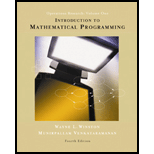
Introduction to mathematical programming
4th Edition
ISBN: 9780534359645
Author: Jeffrey B. Goldberg
Publisher: Cengage Learning
expand_more
expand_more
format_list_bulleted
Concept explainers
Expert Solution & Answer
Chapter 4, Problem 8RP
Explanation of Solution
Optimal solution:
Consider the following linear programing problem:
Subject to the constraints:
Slack variables s1, s2, s3 are added. Therefore, the standard form of the linear
Subject to the constraints:
The initial simplex table is:
| z | x1 | x2 | s1 | s2 | rhs | Basic variable |
| 1 | -5 | -1 | 0 | 0 | 0 | z = 0 |
| 0 | 2 | 1 | 1 | 0 | 6 | s1 = 6 |
| 0 | 1 | -1 | 0 | 1 | 0 | s2 = 0 |
Since the highest negative entry is -5, variable x1 is entered
| z | x1 | x2 | s1 | s2 | rhs | Ratio |
| 1 | -5 | -1 | 0 | 0 | 0 | - |
| 0 | 2 | 1 | 1 | 0 | 6 | |
| 0 | 1 | -1 | 0 | 1 | 0 |
The pivot is 4 in row 3
Expert Solution & Answer
Want to see the full answer?
Check out a sample textbook solution
Students have asked these similar questions
3
2: Solve the following linear program using the simplex method.
Maximize z = 5x₁ + 4x₂
subject to
6x₁ + 4x₂ ≤ 24
X₁ + 2x₂ ≤6
-X₁ + X₂
≤1
X₂
≤2
X₁, X₂ ≥ 0
Which of the following algorithms can be used to find the optimal solution of an ILP?(a) Enumeration method;(b) Branch and bound method;(c) Cutting plan method;(d) Approximation method.
Solve the following problem and find the optimal solution.
Chapter 4 Solutions
Introduction to mathematical programming
Ch. 4.1 - Prob. 1PCh. 4.1 - Prob. 2PCh. 4.1 - Prob. 3PCh. 4.4 - Prob. 1PCh. 4.4 - Prob. 2PCh. 4.4 - Prob. 3PCh. 4.4 - Prob. 4PCh. 4.4 - Prob. 5PCh. 4.4 - Prob. 6PCh. 4.4 - Prob. 7P
Ch. 4.5 - Prob. 1PCh. 4.5 - Prob. 2PCh. 4.5 - Prob. 3PCh. 4.5 - Prob. 4PCh. 4.5 - Prob. 5PCh. 4.5 - Prob. 6PCh. 4.5 - Prob. 7PCh. 4.6 - Prob. 1PCh. 4.6 - Prob. 2PCh. 4.6 - Prob. 3PCh. 4.6 - Prob. 4PCh. 4.7 - Prob. 1PCh. 4.7 - Prob. 2PCh. 4.7 - Prob. 3PCh. 4.7 - Prob. 4PCh. 4.7 - Prob. 5PCh. 4.7 - Prob. 6PCh. 4.7 - Prob. 7PCh. 4.7 - Prob. 8PCh. 4.7 - Prob. 9PCh. 4.8 - Prob. 1PCh. 4.8 - Prob. 2PCh. 4.8 - Prob. 3PCh. 4.8 - Prob. 4PCh. 4.8 - Prob. 5PCh. 4.8 - Prob. 6PCh. 4.10 - Prob. 1PCh. 4.10 - Prob. 2PCh. 4.10 - Prob. 3PCh. 4.10 - Prob. 4PCh. 4.10 - Prob. 5PCh. 4.11 - Prob. 1PCh. 4.11 - Prob. 2PCh. 4.11 - Prob. 3PCh. 4.11 - Prob. 4PCh. 4.11 - Prob. 5PCh. 4.11 - Prob. 6PCh. 4.12 - Prob. 1PCh. 4.12 - Prob. 2PCh. 4.12 - Prob. 3PCh. 4.12 - Prob. 4PCh. 4.12 - Prob. 5PCh. 4.12 - Prob. 6PCh. 4.13 - Prob. 2PCh. 4.14 - Prob. 1PCh. 4.14 - Prob. 2PCh. 4.14 - Prob. 3PCh. 4.14 - Prob. 4PCh. 4.14 - Prob. 5PCh. 4.14 - Prob. 6PCh. 4.14 - Prob. 7PCh. 4.16 - Prob. 1PCh. 4.16 - Prob. 2PCh. 4.16 - Prob. 3PCh. 4.16 - Prob. 5PCh. 4.16 - Prob. 7PCh. 4.16 - Prob. 8PCh. 4.16 - Prob. 9PCh. 4.16 - Prob. 10PCh. 4.16 - Prob. 11PCh. 4.16 - Prob. 12PCh. 4.16 - Prob. 13PCh. 4.16 - Prob. 14PCh. 4.17 - Prob. 1PCh. 4.17 - Prob. 2PCh. 4.17 - Prob. 3PCh. 4.17 - Prob. 4PCh. 4.17 - Prob. 5PCh. 4.17 - Prob. 7PCh. 4.17 - Prob. 8PCh. 4 - Prob. 1RPCh. 4 - Prob. 2RPCh. 4 - Prob. 3RPCh. 4 - Prob. 4RPCh. 4 - Prob. 5RPCh. 4 - Prob. 6RPCh. 4 - Prob. 7RPCh. 4 - Prob. 8RPCh. 4 - Prob. 9RPCh. 4 - Prob. 10RPCh. 4 - Prob. 12RPCh. 4 - Prob. 13RPCh. 4 - Prob. 14RPCh. 4 - Prob. 16RPCh. 4 - Prob. 17RPCh. 4 - Prob. 18RPCh. 4 - Prob. 19RPCh. 4 - Prob. 20RPCh. 4 - Prob. 21RPCh. 4 - Prob. 22RPCh. 4 - Prob. 23RPCh. 4 - Prob. 24RPCh. 4 - Prob. 26RPCh. 4 - Prob. 27RPCh. 4 - Prob. 28RP
Knowledge Booster
Learn more about
Need a deep-dive on the concept behind this application? Look no further. Learn more about this topic, computer-science and related others by exploring similar questions and additional content below.Similar questions
- The following table belongs to the optimal solition nit of a Lineer Programming Problem. Obtain the formulation of the initial problem. XI x2 ke -Jig 38 X₁ Xu O 1 O 19 41 14 23 38 xu O O 1 VI 38 A 38 AL A2 (1-38M) (2-19M) 38 19 -3 38 5 L 응급 31 19 19 solution 7' 2 5arrow_forwardLinear Programming: Graphical Method A. Determine the optimal solution of the following LP problems: Use Desmos Calculator to graph. (Screenshot the graphs and paste here.) Show your complete solution. 1. Maximize: Subject to: Z 4x + 3y ≤ 24 y-x ≤ 4 x, y ≥ 0 = 200x + 350yarrow_forwardQ1: For these Value Obtain U and V and evaluate W when Z = V5 – 2i Q2: If Z1= 4i-3 Z2= 3i Z1+Z2 Find Z2 (2x² x 2 2 Q3: if f(x) = 4 x < 2 find f(x)dx Q4: Show that f (z) = 2z3 – 4z + 1 is satisfy Cauch-Rieman %3D if Z in Cartesian formarrow_forward
Recommended textbooks for you
 Operations Research : Applications and AlgorithmsComputer ScienceISBN:9780534380588Author:Wayne L. WinstonPublisher:Brooks Cole
Operations Research : Applications and AlgorithmsComputer ScienceISBN:9780534380588Author:Wayne L. WinstonPublisher:Brooks Cole

Operations Research : Applications and Algorithms
Computer Science
ISBN:9780534380588
Author:Wayne L. Winston
Publisher:Brooks Cole